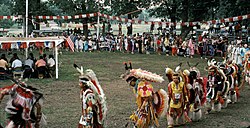Cabalgata Binacional Villista
Each year in February and March, the Cabalgata Binacional Villista commemorates the 9 March 1916 invasion of the United States by Pancho Villa's men. The first cavalcade took place in 1999 and followed the same route that Pancho Villa used, coming from the Hacienda de San Jerónimo, Bachíniva. A handful of riders were expected but more than 125 showed up. The Cabalgata passed Namiquipa and Cruces, as during the original 1916 event. In 2008 the 9th cavalcade began on 27 February in Ciudad Madera with more than 200 riders. [7] During the next 10 days, they traversed 397 km (247 mi) north through towns and villages in northern Mexico (Ignacio Zaragoza, Buenaventura, Galeana, Nuevo Casas Grandes, Casas Grandes, Colonia Graciano Sánchez, Janos, Ascensión, Seis de Enero) to Puerto Palomas de Villa, arriving on 7 March with a complement of 400 riders and twice as many crew.
On 8 March 100 riders continued across the United States–Mexico border 3 miles to the Pancho Villa State Park and Museum in the village of Columbus, New Mexico. From the border the Villistas were accompanied by 200 American riders. The 8th cavalcade in 2007 was larger, with 500 riders arriving in Puerto Palomas de Villa. The 7th cavalcade in 2006 was smaller but the arrival of the 100 Villistas at Pancho Villa State Park coincided with ceremonies attended by New Mexico Governor Bill Richardson, Chihuahua Governor José Reyes Baeza Terrazas, and many other dignitaries. [8] The cavalcade in 2010 was the opening event of the centennial celebrations Tres Siglos, Tres Fiestas (Three Centuries, Three Fiestas). [9] [10]
The riders are received each night with a dinner, rodeo, music and dancing, and their horses are fed and watered. The growing popularity of the cavalcade presented increasing financial challenges for the communities along the route. In 2008, the community presidents formed an association, Presidentes Municipales de la Región Noroeste, to coordinate and manage the event.
Horses traveling from Mexico to the United States normally are subject to quarantine of at least 3 days, [11] but starting in 2006, a special 12-hour waiver was obtained for up to 100 horses (hence the limit of 100 Villistas). Before 2006, the Mexican horses were left behind in Mexico, and the Villistas rode American horses from the border to the park. [12]
The 11th cavalcade in 2010 began on February 23 in Hacienda San Jerónimo, Bachíniva, repeating the historical original route, passing through Namiquipa, Cruces to Buenaventura. There the cavalcade joined the group coming from Madera, continuing together up to Columbus, New Mexico.
Cabalgata Villista
Each year in July the Cabalgata Villista (also known as La Gran Cabalgata Villista) commemorates the assassination of Francisco (Pancho) Villa on 20 July 1923 in Parral. The cavalcade was initiated by José Socorro Salcido Gómez in 1996. It travels to Parral from Chihuahua City, a distance of 220 km (140 mi), led by municipal, state, and federal dignitaries. In general, its route passes through Satevó and Valle de Zaragoza, with riders ( jinetes ) joining the cavalcade along the way. Since 1996 the cavalcade has grown progressively larger; in 2007 3,000 riders participated. The 2008 cavalcade was still larger. [13] In 2009, the cavalcade began with 500 riders departing from Chihuahua City. Participating villages, cities, and municipalities included Matamoros, Valle de Allende, San Francisco del Oro, Santa Bárbara, municipio de López, Zaragoza, El Tule, Huejotitán, Balleza, Coronado, and Jiménez. [14]






